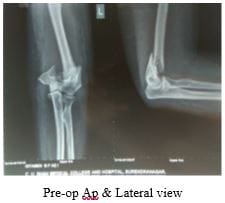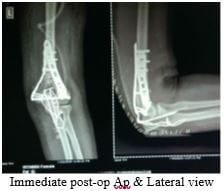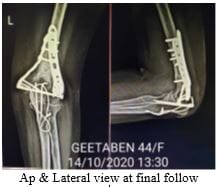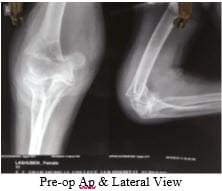A Clinical Study to Evaluate Functional Outcome of Distal Humerus Fractures in Adult Age Group Treated With Different Modalities
Patel H.1, Patel B.2*, Jetpariya D.3, Patel P.4
DOI: https://doi.org/10.17511/ijoso.2021.i05.04
1 Harsh Girishbhai Patel, Senior Resident, Department Of Orthopedics, Banas Medical College, Palanpur, Gujarat, India.
2* Baiju Mukeshbhai Patel, Senior Resident, Department Of Orthopedics, Smt. NHL Municipal Medical College, Ahmedabad, Gujarat, India.
3 Divyesh Pragajibhai Jetpariya, Senior Resident, Department Of Orthopedics, M.P Shah Medical College, Jamnagar, Gujarat, India.
4 Parth Pravinbhai Patel, Final Year MBBS, Department Of Orthopedics, C U Shah Medical College, Surendranagar, Gujarat, India.
Introduction: We live in a society with a growing elderly population and a young population in which extreme sports and high-speed motor transportation are popular. Therefore the incidence of distal humeral fractures is likely to increase. This study evaluates the functional outcome of distal humeral fractures in adults treated with a different modality. Material and Method: This was a prospective study that includes 29 cases of distal humerus fractures who were treated surgically at C U Shah Medical College and Hospital, Surendranagar, from June 2018 to June 2020, in which 17 were females and 12 were males. Result: According to Mayo Elbow Performance Index (MEPI) scoring system, we had 18(62.07%) patients with excellent results, 8(27.58%) patients with good results, 2(6.9%) patients with the fair result and 1(3.45%) patients with poor outcome. Complications were seen in 15 patients, out of which most common was elbow stiffness seen in 7 patients. Conclusion: Open reduction and internal fixation can be considered as the treatment of choice if there is no contraindication for this because it is essential to maintain length, axial alignment, joint congruity and rotational alignment if a good range of motion is to be restored. This is achieved in the present study.
Keywords: Distal Humerus, Dual Platting, K-wire fixation
| Corresponding Author | How to Cite this Article | To Browse |
|---|---|---|
| , Senior Resident, Department Of Orthopedics, Smt. NHL Municipal Medical College, Ahmedabad, Gujarat, India. Email: |
Harsh Girishbhai Patel, Baiju Mukeshbhai Patel, Divyesh Pragajibhai Jetpariya, Parth Pravinbhai Patel, A Clinical Study to Evaluate Functional Outcome of Distal Humerus Fractures in Adult Age Group Treated With Different Modalities. Surgical Rev Int J Surg Trauma Orthoped. 2021;7(5):116-122. Available From https://surgical.medresearch.in/index.php/ijoso/article/view/246 |


 ©
© 


